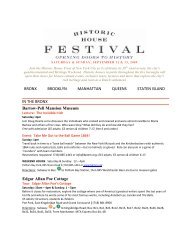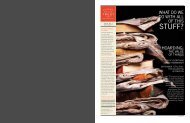Download PDF - The Historic House Trust of New York City
Download PDF - The Historic House Trust of New York City
Download PDF - The Historic House Trust of New York City
Create successful ePaper yourself
Turn your PDF publications into a flip-book with our unique Google optimized e-Paper software.
H I S T O R I C H O U S E T R U S T O F N E W Y O R K C I T Y<br />
H I S T O R I C H O U S E T R U S T O F N E W Y O R K C I T Y<br />
T R U S T S TA F F<br />
—————————————<br />
Rebecca Brainard<br />
Preservation Crew Member<br />
Sarah Brockett<br />
Manager <strong>of</strong> Grants and<br />
Public Programs<br />
Caroline R. Drabik<br />
Curatorial Associate<br />
David C. Mandel<br />
Director <strong>of</strong> Education<br />
& Interpretation<br />
Jonathan Mellon<br />
Resident Engineer<br />
Tara Kiernan<br />
Administrative Coordinator<br />
Meredith A. Sorin<br />
Director <strong>of</strong> Property<br />
Stewardship & Acquisitions<br />
Mikel Travisano<br />
Architectural Conservator<br />
Nahn Tseng<br />
Senior Architectural<br />
Conservator<br />
Franklin D. Vagnone<br />
Executive Director<br />
On our cover:<br />
Walter Gerson cocktail<br />
dress with blue cotton<br />
gloves. Courtesy <strong>of</strong><br />
Susan Bergin at Pocketbook.<br />
• Ieva is holding<br />
a vacuum from the<br />
Lott <strong>House</strong> collection<br />
(Lott# 2005.028 De Lux<br />
Vacuum). • Photograph<br />
by James M. Graham.<br />
<strong>Historic</strong> <strong>House</strong> <strong>Trust</strong><br />
830 Fifth Avenue<br />
<strong>The</strong> Arsenal<br />
Room 203<br />
NY, NY 10065<br />
212 360-8282<br />
f 212 360-8201<br />
A Note from<br />
Franklin D. Vagnone<br />
Executive Director<br />
“It’s very difficult to keep the line<br />
between the past and the present.”<br />
“Little Edie” Bouvier Beale — Grey Gardens (1975)<br />
What gives a house museum both its historical<br />
significance and present-day cultural<br />
relevance? And how do we weave the<br />
lines between our past and our present in authentic<br />
ways? Some may feel the historical value rests<br />
mainly with the social, such as the original owners<br />
<strong>of</strong> the house, their country <strong>of</strong> origin, the period<br />
when it was built, or its physical location in the<br />
community. Others may see value in the material,<br />
such as architecture, collections, fabrics, and<br />
furniture. All <strong>of</strong> these elements matter, and yet still<br />
every house has untold stories, many <strong>of</strong> them<br />
waiting to be discovered. And more importantly,<br />
others still yet to happen.<br />
<strong>The</strong> interpreted life <strong>of</strong> a house museum should<br />
not remain constant; new details emerge which add<br />
new perspectives. Like mirrored pieces in an Isaiah<br />
Zagar mosaic, interpretation reflects back those <strong>of</strong><br />
us who view it. In many instances, it was the mindset<br />
<strong>of</strong> the preservationists and historians who originally<br />
saved the house from extinction which dictated<br />
how the house came to be interpreted. Yet their<br />
involvement in the process should become an integral<br />
part <strong>of</strong> the house’s history as well.<br />
<strong>House</strong> museums (including those in our<br />
collection) and their interpretations are framed by<br />
the social context within which they are restored.<br />
Issues such as immigration, race, economics, politics,<br />
gender roles, nationalism and aesthetics all combine<br />
to create a rather complex series <strong>of</strong> relationships.<br />
This is true <strong>of</strong> the physical restoration work as well.<br />
Projects typically are constrained by a host <strong>of</strong> factors,<br />
with their structures and materials complicated by<br />
<strong>of</strong>ten substantial changes over time.<br />
In this newsletter, we take on this broader<br />
perspective and present a spectrum <strong>of</strong> creative<br />
ways <strong>of</strong> meeting some <strong>of</strong> the challenges that<br />
complicate preservation. From the philosophical<br />
idea <strong>of</strong> preserving dust to contemporary artists’<br />
reimagining <strong>of</strong> our Dutch heritage to HHT’s tangible,<br />
daily preservation efforts at the Latimer <strong>House</strong>,<br />
we consider the complexities <strong>of</strong> deciding how best<br />
to interpret the past.<br />
It is with our feet firmly planted in the<br />
present—with its cultural codes, technology, and<br />
knowledge—that we make our decisions about the<br />
past. While the end result may be a perfectly restored<br />
1780s room, the steps getting there are complex and<br />
influenced by our world <strong>of</strong> today. As you’ll see in<br />
this newsletter, preservation is as much about the<br />
present and the future as it is about the past!<br />
We salute our Corporate Members<br />
Special thanks to<br />
Executive Director Frank Vagnone inspects the<br />
McFarlane-Bredt <strong>House</strong> with Staten Island Parks<br />
Borough Commissioner Thomas Paulo. Built in 1841,<br />
the Italianate house has been greatly altered, including<br />
being divided into apartments. <strong>The</strong> <strong>City</strong> <strong>of</strong> <strong>New</strong> <strong>York</strong><br />
purchased the house in 1975, along with the neighboring<br />
Alice Austen <strong>House</strong>.<br />
For information on corporate membership call 212-360-8282.<br />
1940<br />
BEHIND THE<br />
CLOSED DOOR:<br />
This room was used as<br />
a bedroom or family<br />
parlor. <strong>The</strong> direct access<br />
to the mid 20th century<br />
bathroom highlights the<br />
functional changes the<br />
house underwent. While<br />
its decorations are<br />
less formal, the fireplace<br />
and a china cupboard<br />
indicate that this private<br />
room was still important.<br />
<strong>The</strong> fireplace surround<br />
and molding are Federal<br />
style, with simplified,<br />
more delicate silhouettes.<br />
• <strong>The</strong> wall paper may<br />
date to the 1920s or 1930s,<br />
though this diamondtrellis<br />
design was<br />
popular from the 1850s<br />
into the 1930s. • Handbeaded<br />
black silk cocktail<br />
dress, c. 1940-1945.<br />
Courtesy <strong>of</strong> Susan<br />
Bergin at Pocketbook.<br />
Preservation Across Time: An interview with Jorge Otero-Pailos<br />
Reimagining the Lott <strong>House</strong><br />
By Victoria C. Rowan, Guest Writer<br />
Photography by James M. Graham<br />
<strong>The</strong> Hendrick I. Lott <strong>House</strong> underwent a major<br />
exterior restoration over the past few years.<br />
Its interior, however, remains a jumble <strong>of</strong> peeling<br />
wallpaper, rusting hinges, and weathered wood.<br />
Messy, yes, but at the same time each crumbling<br />
layer represents a different era in the 200-year<br />
life <strong>of</strong> the house, <strong>of</strong>fering us a glimpse <strong>of</strong> trends<br />
and technologies past. As we consider how—and<br />
when—to interpret the house’s interior, we face<br />
the question that confronts all curators <strong>of</strong><br />
historic homes: how will the public ultimately<br />
experience it?<br />
A preservationist who has dedicated his<br />
career to answering that question with some <strong>of</strong> the<br />
most exciting avant-garde theories and dazzling<br />
artistic interpretations is Jorge Otero-Pailos, an<br />
architect, founder/editor <strong>of</strong> the journal Future<br />
Anterior, and pr<strong>of</strong>essor at Columbia University’s<br />
Graduate School <strong>of</strong> Architecture, Planning and<br />
Preservation. HHT turned to him for a different<br />
perspective on preservation.<br />
Visit Jorge Otero-Pailos’s academic<br />
<strong>of</strong>fice on Columbia University’s campus,<br />
and, consistent with the self-effacing<br />
reputation <strong>of</strong> his field, no one would find any<br />
obvious evidence <strong>of</strong> his radical work. Visit his<br />
cyber-residence however—www.OteroPailos.com—<br />
and there one will find a multi-chambered archive<br />
<strong>of</strong> his status-quo-rocking ideas, ranging from his<br />
provocative Future Anterior articles to his own<br />
architectural and art projects. Below are a few <strong>of</strong> the<br />
doors he opened in an interview with HHT.<br />
“What do we preserve?” asks Otero-Pailos.<br />
“Pollution has been the material source <strong>of</strong><br />
preservation’s existence; without it, we would not<br />
have had a need for the discipline and the way which<br />
we relate to buildings would be completely different.<br />
And yet, we never talk about pollution….We have<br />
to recognize that yes, we’ve been caring for buildings<br />
but what we’ve also been caring for is pollution.<br />
For some that is polemical, but in actuality, pollution<br />
is our cultural heritage.”<br />
(continued on page 4)<br />
B O A R D O F<br />
D I R E C T O R S<br />
—————————————<br />
Franny Eberhart<br />
Chair<br />
Myra J. Biblowit<br />
Vice-Chair<br />
John C. Gustafsson<br />
Vice-Chair<br />
Lisa Ackerman<br />
Treasurer<br />
Richard Southwick<br />
Secretary<br />
Deborah Krulewitch<br />
Chair Emerita<br />
Suzanne Stirn Ainslie<br />
George H. Beane<br />
Adrian Benepe*<br />
William L. Bernhard<br />
Henry C. Blackiston<br />
Glenn Boornazian<br />
Thérèse Braddick*<br />
Bruce D. Dixon<br />
Murray B. Douglas<br />
Arthur Norman Field<br />
Kenneth K. Fisher<br />
Timothy C. Forbes<br />
Charlotte Pickman Gertz<br />
Catherine Morrison Golden<br />
Francis C. Grant III, “T”<br />
Carolyn Grimstead<br />
Ted Hammer, FAIA<br />
Susan Kargman<br />
Kate D. Levin*<br />
Jack T. Linn*<br />
Judith MacDonald<br />
Paul R. Provost<br />
Richard Franklin Sammons<br />
Henry J. Stern<br />
Franklin D. Vagnone*<br />
Jeanette Wagner<br />
Cynthia C. Wainwright<br />
Patricia Weinbach<br />
*Ex-Officio<br />
2<br />
winter 2010<br />
winter 2010 3




